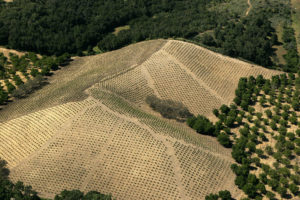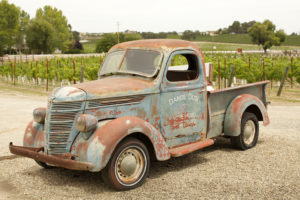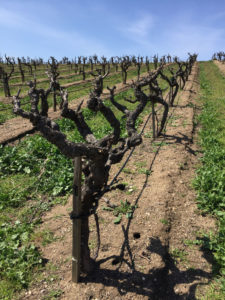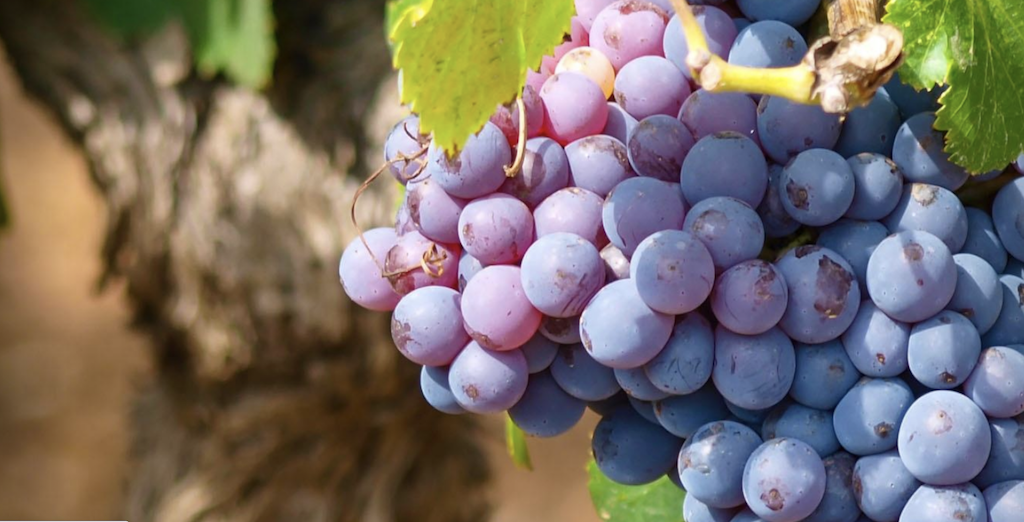It is said so often that it has lost its meaning: “All great wines are made in the vineyard.” But while most clichés have at least some truth to them, this dictum seems to be basically wholly accepted in the wine world. And it is particularly true when it comes to Zinfandel, often referred to as “California’s Heritage Grape.”
Zinfandel vines were brought to this country by European immigrants in the mid-1800s, and the grape prospered in California after the first plantings. Although many of the originally planted Zinfandel vines were ripped out during Prohibition, a few vineyards remained, and even more were planted relatively soon after the repeal of the 18thAmendment in 1933.
There are many of these venerable vineyards throughout California, but the Paso Robles AVA has perhaps one of the highest concentrations of Old Vine Zinfandel vineyards. The region is blessed with at least a dozen or so vineyards that were planted nearly a century ago, which produce some of the most coveted Zinfandel wines in the world. Here are a few vineyards worthy of celebration.
The Oldest
 Any discussion of important Zinfandel vineyards in Paso begins with the Ueberroth Vineyard, which was planted by the Tonesi Brothers in 1885. The dry-farmed site, located close to the Pacific Ocean, is extreme with steep slopes, some reaching up to 45°. The soil primarily consists of rocky limestone, ill-suited for just about any crop except grapevines, particularly Zinfandel.
Any discussion of important Zinfandel vineyards in Paso begins with the Ueberroth Vineyard, which was planted by the Tonesi Brothers in 1885. The dry-farmed site, located close to the Pacific Ocean, is extreme with steep slopes, some reaching up to 45°. The soil primarily consists of rocky limestone, ill-suited for just about any crop except grapevines, particularly Zinfandel.
According to local lore, neither of the Tonesi Brothers produced an heir, with the result that the vineyard changed hands at least a couple of times after they died. Eventually, at some point in the 1960s, Peter Ueberroth (who later became the President of the Organizing Committee for the 1984 Olympic Games in Los Angeles and then Commissioner of Baseball), then in his 20s and a relatively recent graduate of San Jose State, purchased the vineyard and changed its name.
Although the vineyard is still owned by the Ueberroth family, today Turley Vineyards sources 100% of its fruit. Brennan Stover, Turley’s vineyard manager in Paso Robles, fell in love with the vineyard from the moment he first saw it, almost twenty years ago: “I love the Ueberroth because of its extremeness—both the vineyard and the wine. The acidity tends to be higher than other Zins, which leads to depth and complexity.”
Stover said it was an easy decision to leave his native Kansas and come work vineyards for Turley Cellars: “This is the truthful way to grow grapes. You have these gnarly 130-year-old vines that have never been irrigated and are still providing fruit. This is the definition of sustainability.”
The Renowned
 Perhaps the most famous of all Zinfandel vineyards in Paso Robles, however, is the Dusi Vineyard. Sylvester and Caterina Dusi were also Italian immigrants and settled in Paso Robles in the early 1920s. Soon after arriving, they purchased land and in 1925 began planting a forty-acre vineyard on the west side of Paso. Two decades later, in 1945, the family bought additional land less than a half a mile away and planted another vineyard almost exclusively to Zinfandel.
Perhaps the most famous of all Zinfandel vineyards in Paso Robles, however, is the Dusi Vineyard. Sylvester and Caterina Dusi were also Italian immigrants and settled in Paso Robles in the early 1920s. Soon after arriving, they purchased land and in 1925 began planting a forty-acre vineyard on the west side of Paso. Two decades later, in 1945, the family bought additional land less than a half a mile away and planted another vineyard almost exclusively to Zinfandel.
Benito and Dante were sons of Sylvester and Caterina, and when it came time to let the boys take over the farm, it was clear which son would get which vineyard. According to Janell Dusi (granddaughter of Dante), Benito was his mother’s favorite. He never married, never even had a girlfriend—he was always by his mother’s side. In fact, after serving in the Korean War, he never spent a single night away from what was then called the “Home Ranch” and eventually became the Benito Dusi Vineyard.
Dante ended up with the newer, but larger (100 acres) property, now known as the Dante Dusi Vineyard. (Incidentally, there was a third son, Guido, who was also the oldest. Guido was much more outgoing and boisterous than his younger siblings, so he ended up with some of the property that his parents had purchased in downtown Paso Robles, which better fit his personality.)
Despite their proximity, the vineyards are quite different, according to Janell (who makes a Zin from each for her own label, J Dusi Wines): “Benito has a bit sandier soil and a fairly constant elevation. Dante Dusi is more than twice the size with more varied soil and slope changes.”
Over the years, many winemakers have used Dusi fruit to make high-end Zinfandels. Dave Bennion, the founder of Ridge Winery, first bought grapes from Benito and the Home Ranch in 1967, and today Ridge is the main producer of wine from the Benito Dusi Vineyard. Others who have sourced from the Dante Dusi Vineyard are many: Tobin James, Turley Cellars, Four Vines Winery, Chumeia, Stephen Ross, and Meridian.
Given the interest in the fruit from the Dusi Vineyard and its prime location in Paso Robles, it would be easy to justify selling the family property. Janell disagrees: “Selling the vineyard is just not an option. My dad was a farmer, and it is where I grew up, it was my playground, it’s what I know. This is where we all want to be and live. It’s a lot of hard work, but it has provided us with a wonderful lifestyle. Selling would probably enable us to live a little more comfortably, but what would we do then?”
The Legend
 Finally, no overview of Zinfandel in Paso Robles would be complete without a mention of the person who, more than any other, has become intrinsically linked with the region and the variety. Richard (Dick) Sauret was born in Paso Robles in 1935, the third generation of farmers who first came to Paso in 1885. By the time he was 6, he was already working his first grape harvest, and he kept doing so right up until his death in a car accident in September 2017 at the age of 82.
Finally, no overview of Zinfandel in Paso Robles would be complete without a mention of the person who, more than any other, has become intrinsically linked with the region and the variety. Richard (Dick) Sauret was born in Paso Robles in 1935, the third generation of farmers who first came to Paso in 1885. By the time he was 6, he was already working his first grape harvest, and he kept doing so right up until his death in a car accident in September 2017 at the age of 82.
Richard Sauret was a champion of both Zinfandel and dry farming and helped dozens of grape growers plant, maintain, or rescue their Zinfandel vineyards. He owned several vineyards throughout the appellation but started selling them off as he began to wind down his career. One such vineyard, on Nonpareil Road west of Highway 101, he planted in 1965 to his favorite variety, Zinfandel.
Most of the fruit from the vineyard went to Rosenblum’s Sauret Vineyard Designate wine, which was often found on the Top 100 lists of various wine publications. Once Rosenblum became a part of the Constellation portfolio, however, Sauret was not interested in maintaining the relationship, and he sold the vineyard to a young couple in the mid-2000s.
That couple, not quite ready for the difficulties of owning a vineyard (particularly a dry-farmed vineyard in drought-prone California), allowed the vineyard to go fallow. Eventually, Stephanie Shakofsky purchased it in 2017, renaming it Saint Marie Vineyard for her grandmother, who was named after one of the Carmelites of Compiègne, nuns guillotined during the French Revolution (Marie is also Stephanie’s middle name).
Richard, angered by how the previous owners had left the vineyard, had agreed to help Stephanie bring the vineyard back to prominence just weeks before his car accident. Undeterred, she continues the hard work of revitalizing the vineyard, encouraged by the improvement she has seen in her two vintages.
She currently sources all the fruit of her 10-acre vineyard to a small grower in Paso, but sees herself as a “steward to Richard’s legacy, hoping to reproduce the magic of a great vineyard and fantastic winemaker.”
There are at least a dozen more vineyards in the Paso Robles AVA that would be considered “legendary” by almost any measure. Stepping foot in any one of them, looking at the weathered, twisted, gnarly vines, it is easy to imagine the generations of winegrowers who have tended to them over the decades. Tasting the wines produced from their fruit, it is also easy to understand how these great vineyards produce fantastic wines.
Courtesy of Jeff Kralik
https://thedrunkencyclist.com/
